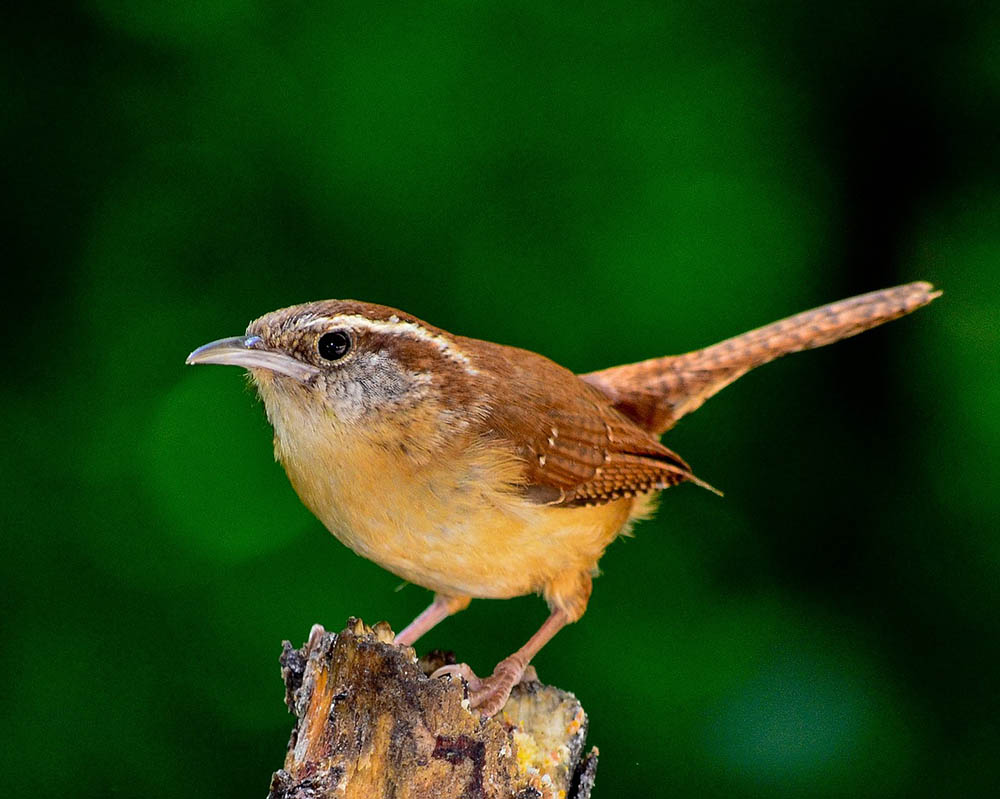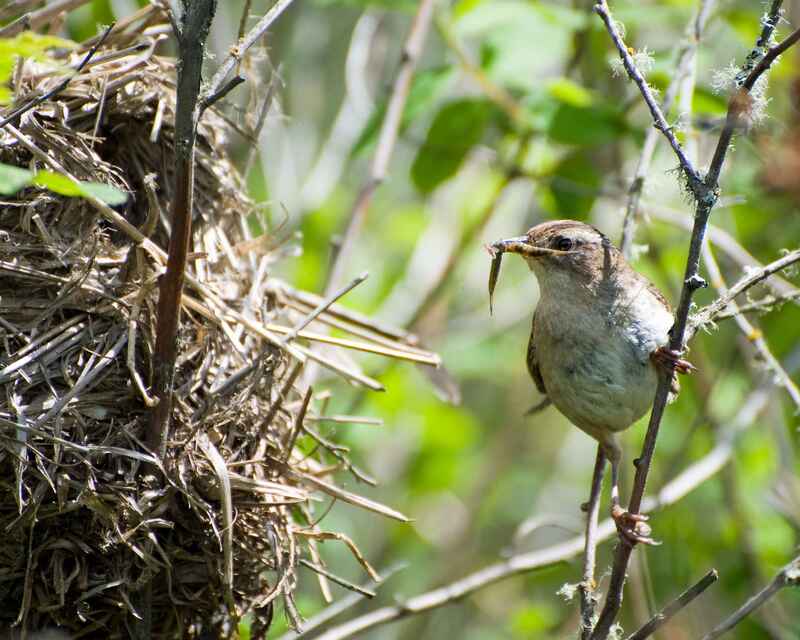10 Fun and Interesting Wren Facts to Know in 2024!
Last Updated on

Wrens are brown passerine birds belonging to the family Troglodytidae.1 The defining characteristics of birds in this family are their small size, brown plumage, and habit of building nests inside hollow trees or other cavities. The family has 88 species and 19 genera.
Wrens, specifically, can be of different types, such as Carolina, House, Canyon, Cactus, Bewick’s, and Marsh. These species differ from each other in terms of their appearance and habitat.
Below, we look at ten of the most interesting facts about wrens.

Top 10 Interesting Wren Facts:
1. Wrens Eat Insects
Wrens typically feed on insects. Although they prefer larvae, they can also eat adult insects. Due to this, it can be difficult to lay out food for house wrens on your garden bird table. Some common insects wrens like eating include mealworms, crickets, grasshoppers, ants, and caterpillars.
If you’re not a huge fan of collecting these insects from your garden to keep the wrens happy, you can also buy soft-bill food from garden stores to make your yard more welcoming for house wrens.

2. Bewick’s Wrens Have an Interesting Family System
When Bewick’s Wrens court, they typically do it monogamously. It means that the pairs only mate with each other and no one else. When the pair sets up the nest, they tend to forage together.
In this way, the male can prevent the female from mating again with another male. When young male wrens come of age, they learn singing from adult males around them. The wren’s father inspires the song with a few differences in syllables and notes.
The young male wren develops a song in the first month or two of their birth and carries it on for the rest of their lives.
3. Cactus Wren’s Young Eat 14 Grasshoppers a Day
Young cactus wrens feed on grasshoppers for their nutrition. Then, the adults feed the nestlings by stuffing grasshoppers into the little one’s mouths.
However, they have to remove the wings before feeding. Since one young Cactus wren must eat at least 14 grasshoppers daily for its nutritional requirements, the parents must catch many grasshoppers.

4. Cactus Wrens Are ”Homewreckers”
Cactus wrens are known to destroy the nests of other birds by throwing out the eggs and scratching up the inside of the nest. As a result, they lower other birds’ breeding densities.
Verdins are desert birds that are specifically affected by this. Cactus Wrens may throw their eggs out of the nest or peck at the nest to destroy their habitat.
5. Canyon Wrens Don’t Drink Water
It’s widely known that Canyon Wrens do not drink water. Instead, they often get their water intake from the insects they eat.
They have a very high metabolism, so their water needs are probably met through the food they eat. Although there have been sights of Canyon Wrens foraging alongside desert springs, they have not been seen drinking.

6. Carolina Wrens Stay Together for Life
A male and female Carolina wren would form a bond at any time of the year. They will then stay together for the rest of their lives.
The Carolina wren is one of the few bird species known to do this. These birds mark their territory and move on it together.
While the male and female Carolina wrens sing different parts of the song, they often interweave their singing to make it seem like it’s coming from one bird.
7. House Wrens and Spiders Form a Team
When House Wrens build their nest in tree holes, they are often affected by parasites, such as mites. Therefore, the birds add insect sacs to their nesting material to fight this infestation.
When the spiders hatch from their sacs, they help to keep the mites in check. In return, the spiders are provided with a safe place to live and food in the form of insects.

8. Pacific Wrens Often Cuddle During Winter
When the weather conditions get too cold, Pacific wrens are known to huddle in the same nest box for warmth. Someone once found 31 Pacific wrens in the same nest box in Washington during a harsh winter.
9. Male Marsh Wrens Build 22 Nests
Male Marsh wrens are busy birds, often building up to 22 nests in a season. The female will lay her eggs in several of these nests, but only one will be used to incubate the young.
A male Marsh Wren typically builds six dummy nests for a mate and can mate with two or more females.

10. Male Rock Wrens Truly Rock
The male Rock wrens are known for their melodious song, which can be heard in the early morning hours. In fact, a single male may have over 100 or more song specialties. They often learn these songs from their neighbors.

How to Attract House Wrens to Your Garden
Although small, wrens are a beautiful addition to any garden. If you’re hoping to attract these little birds to your yard, there are a few things you can do.
- Provide Proper Food: Wrens primarily eat insects. To attract them, try putting out a dish of mealworms or setting up a bird feeder with nyjer seed.
- Offer Nesting Sites: Wrens often nest in unusual places, such as garage shelves and hanging flower pots. You can provide nesting sites by placing a birdhouse in your yard or hanging a straw-filled basket. Wrens prefer a birdhouse with an entrance hole of 1–2 inches.
- Keep Water Outside: It helps to have a birdbath or small pond in your yard, as wrens love to bathe. Just be sure to keep the water clean and fresh for them.

Conclusion
Wrens are undoubtedly some of the most interesting birds you can find in your backyard. Despite their small size, they have a loud song and are very active. If you provide the right food and habitat, you’re sure to attract these delightful creatures to your garden.
Featured Image Credit: theSOARnet, Pixabay
Table of Contents
- Top 10 Interesting Wren Facts:
- 1. Wrens Eat Insects
- 2. Bewick’s Wrens Have an Interesting Family System
- 3. Cactus Wren’s Young Eat 14 Grasshoppers a Day
- 4. Cactus Wrens Are ”Homewreckers”
- 5. Canyon Wrens Don’t Drink Water
- 6. Carolina Wrens Stay Together for Life
- 7. House Wrens and Spiders Form a Team
- 8. Pacific Wrens Often Cuddle During Winter
- 9. Male Marsh Wrens Build 22 Nests
- 10. Male Rock Wrens Truly Rock
- How to Attract House Wrens to Your Garden
- Conclusion
About the Author Jeff Weishaupt
Jeff is a tech professional by day, writer, and amateur photographer by night. He's had the privilege of leading software teams for startups to the Fortune 100 over the past two decades. He currently works in the data privacy space. Jeff's amateur photography interests started in 2008 when he got his first DSLR camera, the Canon Rebel. Since then, he's taken tens of thousands of photos. His favorite handheld camera these days is his Google Pixel 6 XL. He loves taking photos of nature and his kids. In 2016, he bought his first drone, the Mavic Pro. Taking photos from the air is an amazing perspective, and he loves to take his drone while traveling.
Related Articles:
10 Types of Hummingbirds in Arkansas (With Pictures)
8 Types of Hummingbirds in Nebraska (With Pictures)
5 Types of Hummingbirds in Idaho (With Pictures)
3 Types of Hummingbirds in Mississippi (With Pictures)
8 Types of Hummingbirds in Kansas (With Pictures)
5 Types of Hummingbirds in West Virginia (With Pictures)
5 Types of Hummingbirds in Ohio (With Pictures)
Where Do Nuthatches Nest? Nuthatch Nesting Habits Explained
